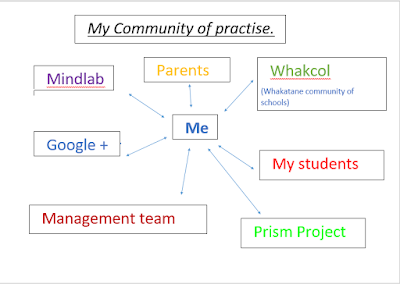A Community and Practice are groups of people who share a passion or concern for something together. With regular interaction and sharing of knowledge they learn how to improve this passion.
The three areas of a community of practise as described by E and B Wenger-Trayner, (2015) are;
- The Domain: A community of practice is not a club of friends or a network of connections between people. It has a shared of interest and membership therefore implies a commitment to the domain, and a shared competence that distinguishes members from other people.
- The community: In pursuing their interest in their domain, members engage in joint activities and discussions, help each other, and share information. They build relationships that enable them to learn from each other.Members of a community of practice do not necessarily work together on a daily basis.
- The Practice: A community of practice is not only a community of interest–people who like certain kinds of movies, for instance. Members of a community of practice are practitioners. They develop a shared repertoire of resources: experiences, stories, tools, ways of addressing recurring problems—in short a shared practice. This takes time and sustained interaction.
My Community of practise.
Management team (teaching team)
Shared domain of interest: In our teaching team, we have developed a strategic plan and vision that
best suits our learning styles. We have developed a plan for increasing our student’s
engagement and academic progress. In this community of practise, we exchange knowledge about and around our curriculum that
best suit the needs of our students. As we are, all educators
and are here for a common reason with a strong focus on accelerating
achievement for our students. Our team also belongs to another Community of
practise and that is Whakcol which is all the schools including secondary
schools bring together common practise and the shared goal of
accelerating achievement for our students in the Whakatane area. The
Whakcol community of practise meets regularly to up skill, share teaching
practises, and solve problems.
Examples of the activities and our Shared Repertoire:
My main
community of practice is my management team (teaching team). We meet
once a week for an hour and half. In these sessions we run PD
(professional development) on a variety of curriculum areas, we developed programmes of learning and collaborate together
with a common goal "how can we move our students?" For example, we
are currently looking at PaCT in our management team. This then flows onto
our Whakcol Community of practise where as a community of schools we
share ideas, examples of student’s work where we mediate work and bring in
other professionals from outside areas. This community then meet 6
times a year or more.
My role within the community of practice:
My role varies from facilitator/ leader to an active member. These change depending on
the curriculum area. In each of my roles I feel collaboration, listening and
taking an active role is the key to a being a good community member. When I am
the leader or facilitator it is definitely is more
challenging for me making sure everything is working
correctly and speaking in from of other educators can be out of my
comfort zone.
Reference:
Cambridge, D., Kaplan, S. & Suter, V. (2005). Community of practice design guide: A Step-by-Step Guide for Designing & Cultivating. Retrieved from https://net.educause.edu/ir/library/pdf/NLI0531.pd...
Etienne and Beverly Wenger-Trayner, 2015, Introduction to communities of Practice. Retrieved from http://wenger-trayner.com/introduction-to-communities-of-practice/
Knox, B. (2009, December 4).Cultivating Communities of Practice: Making Them Grow.[video file]. Retrieved from https://www.youtube.com/watch?v=lhMPRZnRFkk




I know how it feels. That silly comfort zone! how often are you expected to lead or facilitate?
ReplyDeleteThis comment has been removed by the author.
ReplyDelete